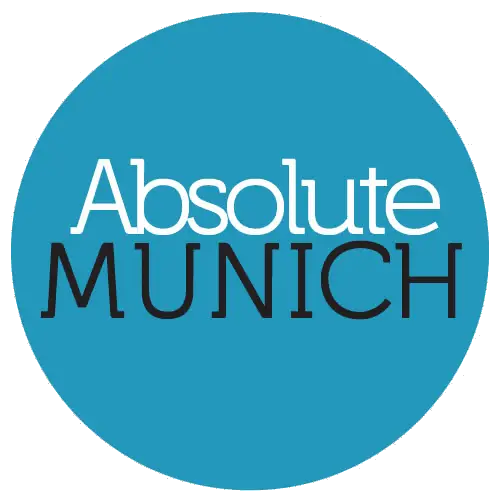Considered one of the last great wild rivers in Germany, the Isar River Munich has been noted more in the past for its destructive potential than for its recreational or liquid qualities.
The river Isar used to flood so regularly and so violently that property loss, danger to life, and local habitat destruction, were just part of normal life in the city.
Pre-Medieval, the Celts and Romans referred to the Isar München as the “Raging One” or the “Tearing One”, such was the force of its unbridled power.
Rudimentary attempts were made throughout the ages to try and control the waters of the Isar to minimise Munich flooding, and finally, with the coming of the industrial revolution, inroads were made.
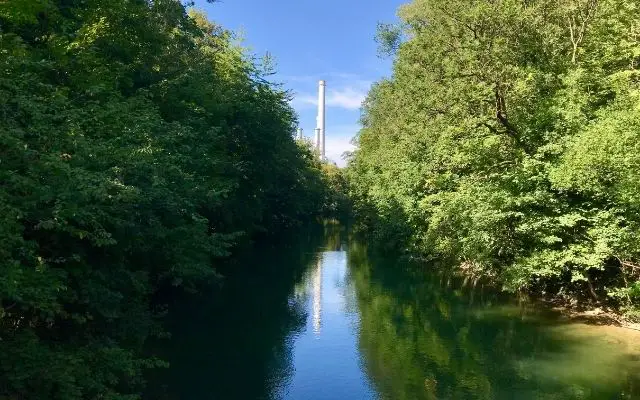
Isar River: A short History
A trade route since pre-historic times, the Isar River has long been associated with the powerful Munich economy.
The excavated medieval foundations of Munich suggest that the city was based on the building of bridges. These bridges over the Isar obviously facilitated trade and created tolls and taxes which all combined and contributed to Munich’s growing prosperity.
As the river is unnavigable by boat, commercial rafting was the mainstay of traffic on the Isar River with most transporting timber, coal, lime, fruit, spices, salt, silks and beer.
At its commercial peak, it’s estimated that some 8000 rafts made their way to and through Munich each year.
By the late 18th century, the Bavarian and Munich administrations, along with a team of ambitious city drafters and engineers, instigated a number of water supply, electricity and sewerage network plans aimed at Munich’s need to control the natural water flow of the Isar.
So it was that in the early 19th Century, a decision was made to canalize the river and also to add a number of weirs and embankments to protect it citizens and control its raging flow.
A number of newly constructed Hydro Electric Plants built throughout the 20th Century were able to harness some of the rivers power and supply electricity to a significant number of Munich households and businesses.
Sadly, the taming of the Isar River made for a quite unattractive watery thoroughfare, and so, in the late 1990’s, a plan was formulated to revitalize and rejuvenate parts of the river within the Munich City boundaries.
Fast forward to the present and it’s clear that the Isar River in Munich now provides many benefits to both the city’s human inhabitants, as well as to the local flora and fauna.
Munich’s newly transformed riverscape is now an attractive recreational destination for the people of Munich, a boon for the cities tourism industry, and a safe and sustainable habitat for the many animals that rely on its meandering waters.
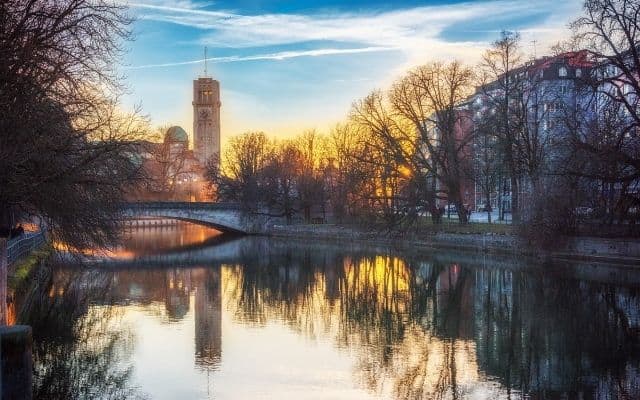
Isar River: Source and Route
On its almost 300 kilometre long route from the Karwendel Alps in the Austrian Tyrol region, to the Danube to the North East of Munich, the Isar flows through many areas of outstanding natural beauty.
The water quality at the Isar’s source is pure, clear and ice cold.
The river traverses gorgeous alpine scenery, grazes beautiful lakes and carries the lifeblood of fresh water to many communities along its route, Munich among them.
At its source in the Karwendel, snow melt and rainfall streams collide in the Hinterau Valley, forming the head of the Isar River. This newly formed waterway then flows on through its initial damming at Sylvensteinsee, onto Bad Tölz and Wolfratshausen and Murnau.
Two kilometres below Wolfratshausen, the Isar joins the handsome Loisach. There is an artificial connection between the two rivers: the Loisach-Isar Canal avoids the risk of flooding for Wolfratshausen.
From Wolfratshausen to the city limits of Munich is the Isar Valley.
Here the Isar cuts deep into a gravel plain, and with wide sweeping gravel banks in places, is one of the fabulous areas to go Hiking in Munich.
Once through the valley the waterway truly becomes a City of Munich River.
Upon exiting Munich the Isar flows north-east through Landshut and onto Deggendorf where it joins the Danube.
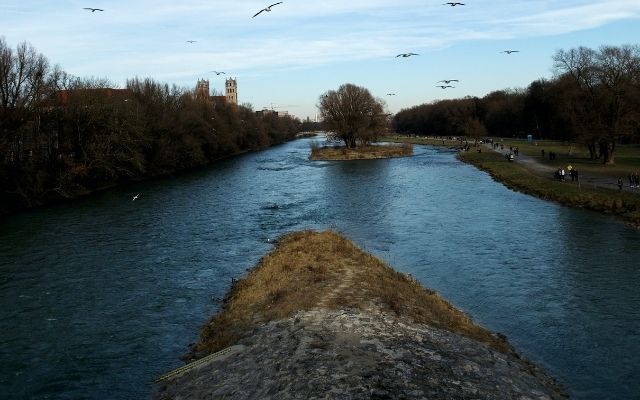
Isar River: Facts and Figures
Except for its 15 km long upper course in Tyrol, the Isar is a Bavarian river through and through.
- The rivers source is around 15 kilometres east of Scharnitz, in the Tyrol.
- The Isar, which rises in the Karwendel Mountains, flows through the Tyrolean Hinterau valley.
- The river flows into the Danube south of Deggendorf.
- Its outflow leads with the Danube into the Black Sea.
- With a total length of 295 kilometres, it is the third-largest river in Bavaria after the Danube and Main.
- Loisach and Amper are the most important tributaries of the Isar.
- The catchment area of the Isar extends over 8,962 square kilometres.
- Munich is the only big city on the Isar, followed by the smaller cities of Landshut, Bad Tölz, Moosburg, Landau and Platting.
- Left tributaries: Loisach, Moosach, Amper, Jachen and Leutascher Ache.
- Right tributaries: Gaißach, Sempt and Walchen.
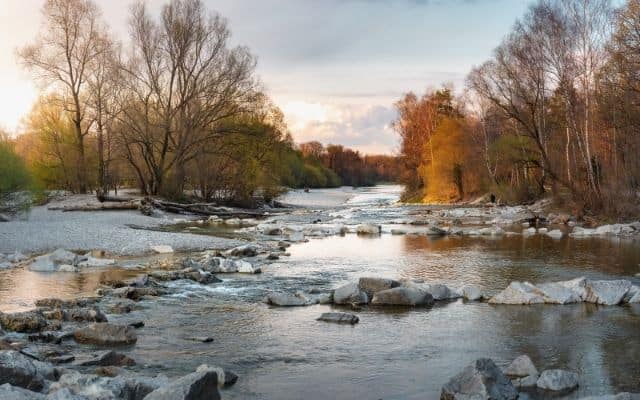
Isar River: Recreational Hotspots
In the catchment area of the upper Isar you’ll find houses adorned with Lüftlmalerei (external mural art), baroque churches with onion domes and farms with abundant floral decorations all embedded aesthetically in a landscape with cosy valleys and majestic mountains.
There are exciting river adventures in the Bavarian Oberland such as rubber dinghy floating, rafting trips, and some excellent fishing areas as well as countless other water sports opportunities.
The Isar River Germany offers loads of different locations for swimming starting in the Karwendel area with the Seinsrautbach in the upper Isar valley in the Karwendel Mountains.
These well-known swimming lakes are only a few kilometres away from Garmisch-Partenkirchen and there are expansive panoramic views over Munich’s highest peaks, the Hochwanner and the mighty Zugspitz.
The Isar was dammed near Sylvenstein between 1954 and 1959 both to provide electricity and to reduce the risk of flooding during times of snow-melt.
Today, the Sylvenstein Reservoir regulates the flow of the Isar and is also a great recreational area for water sports enthusiasts.

Isar River: Waterside Activities in Munich
There is literally so much to see and do along the Isar in Munich that its hard to create a definitive listing of activities. Nevertheless we’ll give it a go:
- Cycling along the Isar: The tranquil Isar cycle path extends over 255 kilometres and meets the Danube cycle path near Deggendorf but there are plenty of cycle ways about Munich on both the main part of the Isar and on the man-made sections of the river flowing through the city.
- Munich River Swimming : When thinking about swimming in the Isar the Flaucher (a city Isar River beach near the Munich Zoo), is probably the most famous stretch for swimming within the city and can be packed in summer time. Munich swimming is also popular elsewhere on the river in the permissible designated areas.
- BBQ’s and Picnics on the Isar: Whilst you are welcome to picnic almost anywhere along the Isar Fluss (River), having a BBQ, much like swimming, is only permitted in designated areas so make sure you find out exactly where those areas of the river are before lighting a kindling or charcoal fire or before sparking up you gas bbq.
- Surfing on the Isar: Yes, unknown to many, Munich is the inland surfing capital of the world with the most famous surfing area being on the initial stretch of the Eisbach Munich (a man made Isar River canal) right at the south end of the Englischer Garten (Munich’s English Gardens). Another regular surfing location in Munich is the Surfwelle Floßlände located right by the entrance to the Thalkirchen Campingplatz.
- Tourism Along the Isar: One of the most famous museums in Bavaria is the Deutsches Museum, and it just happens to be on an island in the middle of the Isar. There are also some amazing churches and government buildings on the banks of the river and some fantastic wooded and green areas, even within the city itself.
- The Isar Germany offers festive fun with beer and brass music commonplace on the famous raft trips that regularly operate between Wolfratshausen and Munich. The rides on the specially assembled rafts have thankfully become strictly regulated in recent years to provide better levels of safety and are great fun for young and old alike.
There are many sights and day trip excursion destinations along the Isar within an hour’s travel of Munich both north and south of the city.
Popular with children and young families is the Wolfratshausen Fairy Tale Forest.
This theme park is based on twenty fairy tales by the Brothers Grimm and the Arabian Nights which are represented by moving figures, sculptures and scenes.
The fantastic “Generations Playground” features interactive and imaginative games, activities and quests to suit all age groups.
For adults we’d definitely recommend a visit to the “Weihenstephan Bräustüberl”. The former monastery brewery serves delicious Bavarian food in a magical atmosphere just a couple of hundred meters from the Isar at Freising, north of the city.
Lovers of fine “barley juice” (beer) will also get their money’s worth here, and they can drink their beer in one of the oldest breweries in the world.

Isar River : Flora and fauna
Aside from its obvious positive points of social usability within the Munich city limits, the Isar is home to many endangered bird species.
These birds breed regularly on the undisturbed, mostly vegetation-free, gravel islands of the Isar and along the river banks.
The common tern (Sterna Hirundo), a very elegant flyer, usually lays one to three eggs in a nest hollow directly on the gravel floor of the river.
In the last 30 years, the tern population has been successfully repopulated in Bavaria by specially set up brood rafts (bird nesting aids) along the Isar River.
Some individuals from a formerly larger population still exist in the area of the Pupplinger Au, south of the city of Munich near Starnberg, which is where the breeding program originated.
The endangered common Sandpiper (Actitis Hypoleucos) and the endangered Little Ringed Plover (Charadrius Dubius) can also be found on the Isar in addition to the common tern.
There are also many returned fish species that spawn in the gravel of the Isar, such as the common barbel, common nase, and of course the trout.
These fish prefer clear water so it’s up to us to be as respectful as possible when relaxing and socialising along the rocky riverbed of the Isar.
Many amphibians and small invertebrates such as freshwater crabs and mussels have returned to the Isar River within Munich thanks to the increase in micro-organisms as the rivers program of re-naturalisation continues to improve the quality of the water for the ecosystems that rely on the river for survival.
Isar River: Interest Points Map
This Absolute Munich map of inner-city Munich highlights the most interesting points along the river within the city limits of Munich.
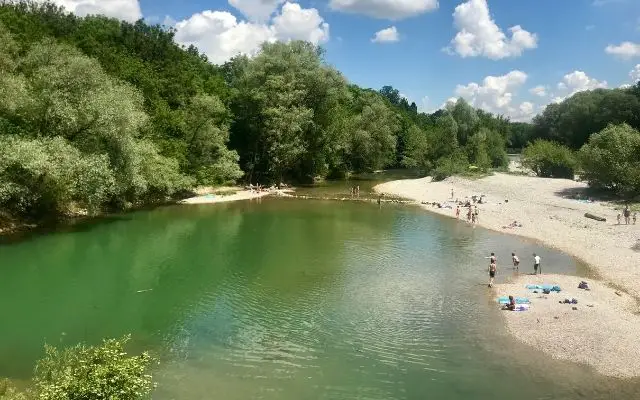
Isar River: A River for the People
The Isar has always been an identity-forming factor for the city and its people, yet the fragile relationship between Munich’s residents and the Isar has been strained at times due to the regular destruction bought about by flooding.
In the course of the 19th and 20th centuries, the Isar Munich was forced into a manageable corset, made of stone and concrete, specifically to control the raging river waters, so little was left of the original mountain river and for a period, the city turned away from the Isar.
Its banks became lanes for car traffic, especially in the inner city, and the river became almost removed from nature and was seemingly uninviting for Munich residents.
As a result of the rivers program of re-naturalisation work, the Isar has now once again acquired attractiveness for its residents, something that is unique for a waterway through a large city.
Thanks to the extensive elimination of the canalisation, many Munich residents now experience the Isar as a near-natural river, and it is now used enthusiastically so, once again.
Environmental lovers and Green supporters alike now see it as a priority task to protect the nature that has been regained on the Isar in the best possible way and at the same time to preserve it as a recreational area for Munich residents.
The Isar is of great value in urban ecology: it is an essential fresh air corridor across the city and a vital climate regulator, all serving to to protect the natural landscape and biodiversity, especially within the Munich City limits.
It flows across the city in a 14-kilometre long stretch interspersed with watery off-shoots and small man-made sections.
Along its banks are innumerable beer gardens, endless walks, kiosks and much more to enjoy, increasing the recreational value of the city enormously.
The Isar really is a “River of the People”, and mutual respect now flows both ways.
Thanks for reading!
